Sheldon Brown's
Bicycle Glossary I - K

|
![]()
I.G. sprockets are very slightly thicker than Hyperglide ones, and some Shimano Hyperglide chains may hang up if used on an I.G. cassette. The slightly wider I.G. chains work on either type, as do SRAM chains. I.G was available only with 7-speed cassettes.
If your bike has old fashioned friction shifters, consider upgrading to a modern indexed system. This is a major, very worthwhile upgrade.
Internal-gear hubs have had index shifting throughout their history.
Parts must be matched for index shifting to work correctly: the shift control must match the derailer and cassette sprocket spacing, or the internal hub. Use of mismatched or misadjusted components can put your bicycle in a "between gears" condition.
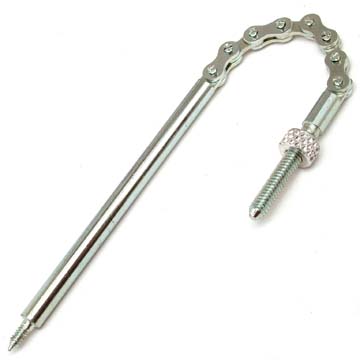 Indicator Spindle, Indicator Rod
Indicator Spindle, Indicator Rod Sturmey-Archer term for the small chain and shaft which fit into the axle and connect the shift cable to the internal parts of many internal geared hubs.
Sturmey-Archer indicator spindles are of a number of different lengths, to fit different hubs. Also see our article about them.
Gear systems in which the gear shifting mechanism is built into the hub of the rear wheel. This is usually accomplished by the use of planetary gears.The most widely known form of internal gearing is in the three-speed utility bicycle. 4-and 5-speed hubs have also been available for many years, but went out of fashion during the early '70's bike boom. Shimano, SRAM (formerly Sachs) and Sturmey-Archer have revived them, and also marketed 7- and 8-speed hubs, Shimano an 11-speed as well. SRAM also offered a 9-speed model but as of 2017 has abandoned the internal-gear hub market. Rohloff offers a 14 speed model. Fallbrook Technology's NuVinci hub is continuously variable, essentially offering an infinite number of "gears."
Internal gearing is usually heavier and more expensive than derailer gearing. Bicycles with internal gearing usually have fewer speeds than comparable bicycles with derailer gears, and the mechanical efficiency is sometimes less with internal gearing.
Internal gears are generally more reliable than derailer gears, especially for bicycles which are used in wet or dirty conditions, because the gear mechanism is all contained within the rear hub, out of harm's way. The other great advantage of internal gears is that they can be shifted even when the bicycle is at a stop. This feature makes them particularly suitable for use in stop-and-go city traffic.
Not all internal gears are built into the rear hub, there are also models that are built into the bottom bracket.
Internal gears may also be combined with derailers to produce "hybrid" gearing. This system is particularly useful for bikes with smaller-than-usual drive wheels, such as folding bikes and some recumbents, as it provides a way to get adequate high gears without requiring unusually large chainwheels .
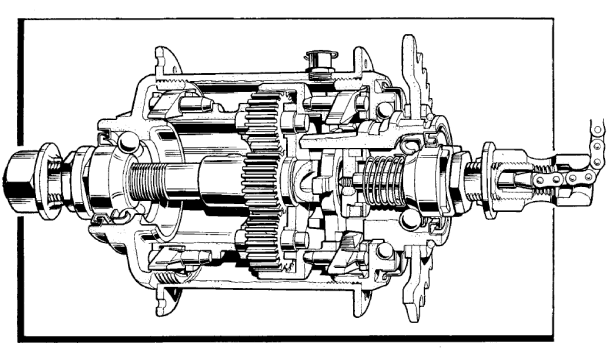
Classic Sturmey-Archer AW 3-speed Internal Gear Hub
The practice of running gear or brake cables through the inside of a frame, instead of outside. This is usually done for the sake of making the bike look nicer. Unfortunately, internal cable routing usually degrades performance by increasing weight and cable friction. It can also make servicing the bicycle more difficult.
![]()
![]()
Instead of pulling on the inner cable, interrupter levers activate the brakes by pushing on the cable housing.
These are an updated version of the extension levers popular in the late '70s, without the drawbacks of the older designs.
This style of brake lever was first popularized by cyclocross riders, with the result that they're sometimes known as "cross levers" or "cyclocross levers" but there is actually nothing about them that makes them more suitable for cyclocross bikes than for any other drop bar application.
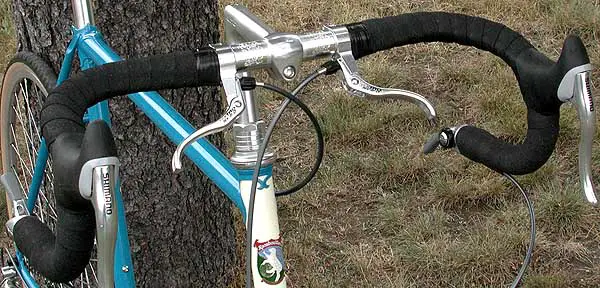
Since tires are made by molding, not by cutting or sticking tread features on, this distinction is somewhat theoretical, and some tires have characteristics of both types.
"Inverted" tread tires typically have a more continuous contact area with the riding surface, so they give a smoother ride on pavement than knobby treads do. They can also give a better grip on loose, uneven surfaces than smooth tires do. They are mainly used as a compromise on- off-road tire. They don't grip as well in sand and mud as serious knobbies, and they are heavier and have more rolling resistance than smooth tires intended for paved surfaces.
This process is explained in detail at: https://juxtamorph.com/the-lost-wax-casting-process/
![]()
![]()

The use of the ISIS Overdrive mounting dimension does not specifically require the use of ISIS splined cranks, but that is the usual configuration.
The major exception is the bottom bracket. Italian bottom brackets are 70 mm wide, as opposed to the usual 68 mm dimension of British/ISO and French bottom brackets. The cup diameter is also larger. Sometimes, bicycles which have damaged bottom-bracket threads are machined out to Italian size to eliminate the damaged threads. Italian bottom brackets, like the French, use a right-hand thread on both sides, so the fixed cup is prone to loosening up unless very securely tightened or secured with threadlock compound.
Italian threading is a curious mixture of metric and British. Diameters are specified in millimeters, but threads are in threads-per-inch! In addition, the thread angle is 55 degrees, as with the obsolete British Whitworth system, rather than 60 degrees as with U.S. and metric threads.
Italian freewheel and headset threads are the same as British/ISO, except for the thread angle difference. They may be interchanged, but you should not go back-and-forth between Italian and British/ISO headsets. Italian freewheels are basically extinct, so the issue is moot there. Italian-size handlebars/stems generally use a clamping diameter of 26 mm. Many high-end aftermarket drop handlebars and "road" stems also use this size even if not Italian-made.
Since the standards were adopted, innovation and product differentiation have resulted in a proliferation of parts that no longer conform to them, because these parts are designed entirely differently. This has occurred with spokes, headsets, bottom brackets, chains, sprockets...
![]()
![]()
J.I.S. fork crown seats are 27 mm in diameter, instead of 26.4 mm
J.I.S. head tube inside diameter is 30 mm, instead of 30.2mm
J.I.S. square-taper bottom-bracket axles use a marking system which is consistent across numerous brands.
The governing body of Keirin racing is N.J.S. (Nihon Jitensha Shinkokai-the Japanese Bicycling Association.)
For more details, see the Wikipedia entry for Keirin.
"Key spoke" is a term I coined to designate the first spoke installed when building a new wheel.
Another type of keyed washer fits a shaft that is round but has one (or more) flat side(s). French forks usually use this system, with a simple filed flat on the back of the steerer.
Bendix (U.S. company) made 3 models, distinguished by colored stripes running around middle of the hub shell.
Sachs/Torpedo (West Germany) also used to make a kick-back hub. These were most commonly installed on folding/take-apart bikes, where they offer the advantage of not requiring any cables to run from the front to the rear of the bike.
The Sachs/Torpedo hub, unlike the Bendix, did allow sprocket interchangeability, using the same 3-splined sprockets used by most other multi-speed hubs (Sturmey-Archer, Shimano, SRAM/Sachs, etc.) Sprockets are available from 13-24 teeth. The Sachs/Torpedo unit is also quite a lot smaller than the Bendix models. SRAM, which purchased Sachs, introduced a kick-bakc hub shortly before it stopped producing internal-gear hubs.
Sturmey-Archer currently (2017) makes kick-back hubs with and without a coaster brake.
![]()
![]()
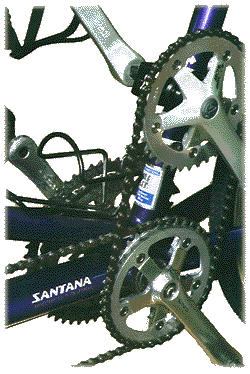
Knobby tires perform extremely badly on paved surfaces. The knobs greatly increase rolling resistance, and create annoying vibrations. They also corner badly on pavement, due to squirm.
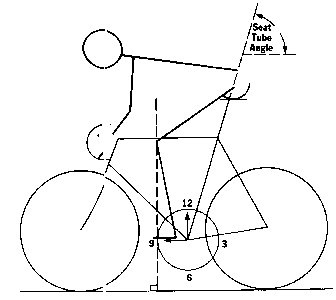
This approach is quite popular with racing coaches, but it is by no means clear that this is a good setup for general cycling. Many recreational riders prefer a more rearward saddle position than this, with the extreme case being the recumbent position.
Some triathletes and time trialists prefer a more forward position. This is generally an approach that is used with æro type handlebars and arm rests.
See also Keith Bontrager's article "The Myth of K.O.P.S." and my article on Frame Sizing
![]()
![]()
![]()
Last Updated: by Harriet Fell